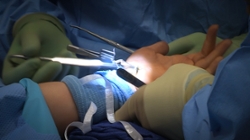Innovation: Giving Patients 'What they Love Before they Know they Want it'

“Jen, why so quiet?…Would you like to see what we’ve done?”
Jen Simonds sits up and leans over a blue surgical drape to get a bird’s eye view of the white, chopstick-sized tendons exposed through an incision in her wrist. She listens intently as Douglas Hutchinson, M.D.—or “Hutch”—explains how he has cut and released the ligament that’s been pressing down on one of her nerves and causing pain, numbness and tingling in her left hand.
Being conscious for surgery may sound like a frightening throwback to the days before anesthesia. But the practice is taking hold as a low-risk, low-cost and patient friendly approach to a growing number of procedures. “Most patients say, ‘Oh, I can roll up my sleeve, you can inject me with a local anesthetic and do the surgery, and I can walk out of there in a matter of minutes with my coffee cup still in my hand? That’s fantastic,’” says Hutchinson, chief of hand surgery at University of Utah Health Care.
If anything, it’s doctors who tend to take some convincing. Carpal tunnel surgery is a common procedure with great outcomes, low complication rates and high patient satisfaction. So, why mess with success?
That was the initial response Hutchinson received from some of his colleagues when he proposed moving his carpal tunnel surgeries from the operating room to an outpatient setting. Some voiced worry that patients wouldn’t tolerate the numbing injection without sedation. Then there was the challenge of securing extra space—not to mention, disrupting the normal workflow for doctors, registration clerks and nursing staff. “Change is hard, especially when everyone’s happy with the status quo, including patients,” Hutchinson says.
It's a pervasive dilemma in health care. Though the industry is in flux, and we know "business-as-usual" can't last, there’s no real urgency to change because the old way of doing things is still lucrative.
But as author and business consultant Adrian Slywotzky puts it: Innovation is about “giving people what they love before they know they want it.” Tech companies like Amazon, Apple and Google succeeded because they paid attention to the hassles consumers faced buying books, renting movies or using their cell phones, says Slywotzky, a partner of the management consulting firm, Oliver Wyman.
Successful health organizations must do the same, and ask how they can alleviate the hassles patients face in booking appointments, undergoing procedures, filling prescriptions and paying hospital bills. “The biggest problem in business is staying with your previously successful business model one year too long,” he says.
The reality is health care is changing and as consumers shoulder more of the cost of their care, they’re becoming more discriminating about where they spend their money, says Charles Saltzman, M.D., orthopaedic department chairman at the U. And wide awake carpal tunnel surgeries not only produce great outcomes, they’re more convenient and cost-effective.
Freed from having to prep patients for the operating room and monitor their recovery afterward, Hutchinson’s team is now able to do more surgeries in less time and for about a third of the cost—making it easier for patients to schedule appointments and sparing them the risks and side effects of anesthesia. “I didn’t have to arrange transportation or take a lot of time off work,” says Simonds who strategically scheduled her surgery before a holiday weekend. “The only thing I missed were a couple of meetings and office hours.” 
Instead of administering sedating drugs through an IV, Hutchinson numbs the wrist with an injection. Patients don’t have to refrain from eating or drinking. They can carry on a pain-free conversation with Hutchinson throughout the surgery and stand up and leave immediately after.
The shift has led to other efficiencies at the hospital by freeing up operating room time for more complicated surgeries. “It just makes sense. We love it, and so do the patients,” says Clark Monk, a nurse in Hutchinson’s unit.
It’s also better for the environment, because outpatient procedures require less equipment and produce less medical waste. “We’ve whittled a three-hour process down to 30 minutes, from registration to discharge,” Hutchinson says. “Now I have doctors asking me if we can do other kinds of surgeries this way.”
Wide awake surgery doesn’t appeal to every patient, nor is it always appropriate, says Hutchinson. “If I’m doing multiple things, like carpal tunnel plus three trigger fingers, or we need a lot of x-rays, it can get tricky.”
But Simonds, who reacts poorly to anesthesia, wouldn’t have it any other way. Hoping to avoid surgery, the psychology professor first tried wrist splints and hand exercises but her condition worsened. Hutchinson has now operated on both of her wrists. “It has made such a difference and been such a relief,” she says.
Being alert for the procedures gave her comfort and helped her feel more a part of the whole process. “I thought about becoming a doctor in elementary school, so the biology of it interests me,” says Simonds. “It’s low cost and low hassle, and really not much more involved than getting a filling at the dentist.”
Kirsten Stewart is a senior writer for University of Utah Health Sciences
